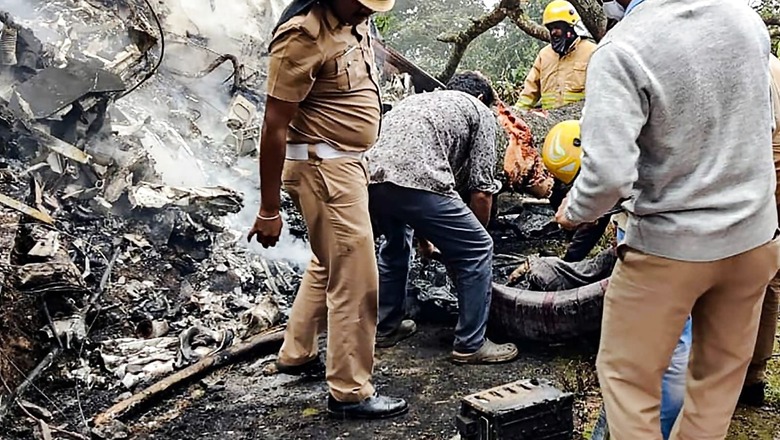
views
More than half a dozen Mi-17 helicopter accidents have taken place in India over the years, and investigations have brought to the fore several factors, which led to the crashes. In some of the cases, the probe is still underway.
In one case, minor negligence led to the loss of a cabin crew member’s life while in another, it was the lack of availability of the fire-fighting system, which perhaps, was the reason behind the casualties in the crash of Chief of Defence Staff General Bipin Rawat’s Mi-17V5 helicopter on December 8, though the investigation will reveal the actual cause of casualties and accident.
The investigation reports usually take about a year as the lengthy procedure includes details about the aircraft or helicopter, its maintenance record, load sheet, the previous record of the helicopter, information about all parts, crew flying hours, capabilities, fitness, weather conditions among others.
Role of Black Box
The black box helps determine the cause of the helicopter or aircraft crash. It records cockpit conversations and the performance and condition of an aircraft or a helicopter. These two things help investigators know the details about the performance of a helicopter or an aircraft and the last conversation of pilot and co-pilot before it crashed. Mi-17 helicopters are fitted with a Digital Flight Data Recorder and Cockpit Voice Recorder. Both are fitted in the tail boom, adjacent to each other. It records multiple analogue and discrete parameters. To decode the data, the details are sent to Moscow as the helicopter is Russian-made or investigators request the manufacturer to visit India, which remains unlikely to be fulfilled.
Mi-17 Accident in 2011
Pawan Hans Helicopter Mi-172 helicopter, carrying 23 persons, including 4 crew members and 19 passengers and aircraft maintenance engineers, met with an accident in 2011 in Arunachal Pradesh. The flight from Guwahati to Tawang Civil Helipad was uneventful. However, while reaching the helipad, the helicopter descended below the level of the helipad and it toppled over to left. After rolling to the left, the helicopter caught fire. There were 19 fatalities. The helicopter was destroyed by fire just like what happened to CDS Rawat’s Mi-17V5 chopper, in which his wife and 11 others were travelling.
What the Investigation Report Says
Air Marshal (Retd.) PP Rajkumar, who was the in charge of the investigation, in his report said, “The accident was survivable. However, people died mainly due to inadequate fire services and non-availability of crash equipment and trained personnel."
The report also said the accident occurred as the helicopter undershot the helipad and sunk below the height of the helipad. The rotors hit the beginning of the helipad and broke. The helicopter slid on a slope and almost turned over on its back after the accident.
Subsequently, it caught fire and was destroyed.
The report also further said the contributory factor for the accident was the inadequate use of Met resources. Aircrew had disregarded the local pressure setting and temperature given by Tawang Control.
Mi-17 Accident in August 2010
Pawan Hans Helicopter Mi-172 departed from Itanagar in Arunachal Pradesh in the morning on August 6, 2010. The helicopter departed from Namsai for Tezu at around 11 am and a few minutes after the departure the left-hand door opened and a cabin crew fell from the helicopter in a field of Sengsap village about 7.5 km in the east of Namsai Helipad. The cabin crew was rushed to Namsai hospital where he was declared brought dead. All other persons on board the helicopter escaped unhurt.
What the Investigation Report Says
After the take-off from Namsai, the technician had seen that the cabin crew removed his seat belt and left his seat and bent towards the door. He was seen pulling the door cables and trying to move the latch. He also called the technician to help him. The technician saw the door handle was in ‘OPEN’ state. It appeared that the cabin crew could not latch the door before take-off from Namsai because the latch might have moved beyond the ‘CLOSE’ position mark. He had only locked the door by turning the door handle to the ‘CLOSE’ position. For this reason, there was no ‘door warning light’ in the cockpit before the take-off. Whether he had intimated the pilot-in-command on ‘intercom’, the door closure could not be confirmed independently as the Cockpit Voice Record of the sector was not available.
After the take-off, the cabin crew probably decided to latch the door by opening it a little bit for correcting the latch position. That is why, he turned the door handle to the ‘OPEN’ position and called the technician for help while he kept pulling the door cable. In his attempt to open the door a bit, the door opened fully by the thrust of air. As the cabin crew was holding the door cables; he fell while opening of the door. The technician also slipped out but managed to enter the helicopter.
Read all the Latest India News here




















Comments
0 comment